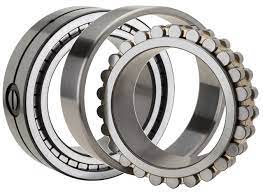Cylindrical roller bearings, also known as a rolling bearing, is a bearing which carries a load by placing rolling elements (such as balls or rollers) between two bearing rings called races. The relative motion of the races causes the rolling elements to roll with very little rolling resistance and with little sliding.
One of the earliest and best-known rolling-element bearings are sets of logs laid on the ground with a large stone block on top. As the stone is pulled, the logs roll along the ground with little sliding friction. As each log comes out the back, it is moved to the front where the block then rolls on to it. It is possible to imitate such a bearing by placing several pens or pencils on a table and placing an item on top of them. See “bearings” for more on the historical development of bearings.
A rolling element rotary bearing uses a shaft in a much larger hole, and cylinders called “rollers” tightly fill the space between the shaft and hole. As the shaft turns, each roller acts as the logs in the above example. However, since the bearing is round, the rollers never fall out from under the load.
Rolling-element bearings have the advantage of a good trade-off between cost, size, weight, carrying capacity, durability, accuracy, friction, and so on. Other bearing designs are often better on one specific attribute, but worse in most other attributes, although fluid bearings can sometimes simultaneously outperform on carrying capacity, durability, accuracy, friction, rotation rate and sometimes cost. Only plain bearings are used as widely as rolling-element bearings.
What are the use Cylindrical Roller Bearings?
- Oil and gas.
- Gearboxes.
- Wind turbines.
- Machine tool.
- Electric motors.
- Material handling.
- Pumps.
- Steel mills.
How cylindrical roller bearings work
As their name suggests, cylindrical roller bearings are cylinders that are arranged between the inner and outer races. These cylinders, which are shaped like soda cans, roll along their sides in the tracks of the races. The elements can only roll along a single axis, unlike balls which can roll in any direction.
What are the different elements of roller bearing?
There are five types of rolling elements that are use in rolling-element bearings: balls, cylindrical rollers, spherical rollers, tapered rollers, and needle rollers.
Why does a cylindrical roller bearing require a heavy duty separator?
The role of the separator is to maintain an equal distance between the rolling elements. The races are the outer ring or the inner ring of a bearing. The raceway is the path of the rolling element on either ring of the bearing.
How do you check roller bearings?
Separable bearings such as tapered roller bearings may checked by individually examining their rolling elements and the outer ring raceway. Large bearings cannot rotated manually; however, the rolling elements, raceway surfaces, cages, and contact surface of the ribs should be carefully examined visually.
What is advantages of cylindrical roller bearing?
- Separable design for simple mounting & dismounting.
- Interchangeable design Inner Ring can exchanged.
- Suitable for high speed applications.
- Heavy radial loads.
- Accommodates axial displacement.
What are disadvantages of rolling bearings?
- More noisy at very high speeds.
- Low resistance to shock loading.
- More initial cost.
- Design of bearing housing complicated.
When would you use a cylindrical roller bearing?
Cylindrical roller bearings, in which either the inner or outer rings has two ribs and the other ring has one, are capable of taking some axial load in one direction Double-row cylindrical roller bearings have high radial rigidity and are used primarily for precision machine tools.
Why we use Teflon in bearings?
PTFE(Teflon) has an exceptionally low coefficient of friction and high self-lubricating characteristics, resistance to attack by almost any chemical, and an ability to operate under a wide temperature range.





